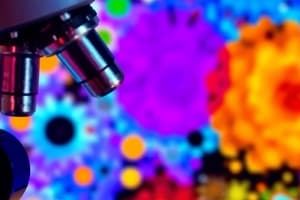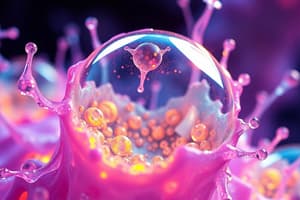Podcast
Questions and Answers
Phase contrast microscopy can be used to visualize living cells without fixation or labeling.
Phase contrast microscopy can be used to visualize living cells without fixation or labeling.
True (A)
Fluorescence microscopy uses a lower intensity light source to excite fluorescent molecules.
Fluorescence microscopy uses a lower intensity light source to excite fluorescent molecules.
False (B)
The main advantage of phase contrast microscopy is the high contrast images it produces.
The main advantage of phase contrast microscopy is the high contrast images it produces.
True (A)
Phase contrast microscopy is effective for observing thick specimens without distortion.
Phase contrast microscopy is effective for observing thick specimens without distortion.
A phase plate slows down the background light by ½ wavelength.
A phase plate slows down the background light by ½ wavelength.
Phase contrast microscopy makes special preparation such as fixation or staining unnecessary.
Phase contrast microscopy makes special preparation such as fixation or staining unnecessary.
Phase contrast images can sometimes suffer from reduced resolution due to phase annuli.
Phase contrast images can sometimes suffer from reduced resolution due to phase annuli.
Fluorophores are also referred to as fluorescents.
Fluorophores are also referred to as fluorescents.
A bright field microscope shows a dark image against a bright background.
A bright field microscope shows a dark image against a bright background.
In bright field microscopy, only scattered lights are allowed to enter the objective lens.
In bright field microscopy, only scattered lights are allowed to enter the objective lens.
Bright field microscopy is also known as a compound microscope.
Bright field microscopy is also known as a compound microscope.
Both stained and unstained specimens can be observed under a bright field microscope.
Both stained and unstained specimens can be observed under a bright field microscope.
The objective lens in a bright field microscope is located below the stage.
The objective lens in a bright field microscope is located below the stage.
Living specimens of bacteria can be observed under a bright field microscope.
Living specimens of bacteria can be observed under a bright field microscope.
A condenser lens is used to focus light rays on the specimen in bright field microscopy.
A condenser lens is used to focus light rays on the specimen in bright field microscopy.
Bright field microscopes are known for being expensive and complex.
Bright field microscopes are known for being expensive and complex.
Polarized microscopy enhances contrast to evaluate the composition and 3D structure of specimens.
Polarized microscopy enhances contrast to evaluate the composition and 3D structure of specimens.
The polarizer in polarized microscopy makes light vibrate in multiple directions.
The polarizer in polarized microscopy makes light vibrate in multiple directions.
If the polarizer and analyser are placed perpendicular to each other, total darkness is observed.
If the polarizer and analyser are placed perpendicular to each other, total darkness is observed.
Birefringent specimens can produce two individual wave components when light passes through them.
Birefringent specimens can produce two individual wave components when light passes through them.
Anisotropic substances have uniform physical properties regardless of the measurement direction.
Anisotropic substances have uniform physical properties regardless of the measurement direction.
The main application of polarized microscopy is in studying fluids like water.
The main application of polarized microscopy is in studying fluids like water.
Constructive and destructive interference occurs when light passes through the analyser after exiting the specimen.
Constructive and destructive interference occurs when light passes through the analyser after exiting the specimen.
The polarizer is placed above the specimen stage in polarized microscopy.
The polarizer is placed above the specimen stage in polarized microscopy.
Fluorescence occurs when a substance absorbs light at a longer wavelength and emits light at a shorter wavelength.
Fluorescence occurs when a substance absorbs light at a longer wavelength and emits light at a shorter wavelength.
Fluorescence microscopy combines the properties of light microscopes with fluorescence technology.
Fluorescence microscopy combines the properties of light microscopes with fluorescence technology.
The light source used in fluorescence microscopy can include Xenon and Mercury Arc Lamps.
The light source used in fluorescence microscopy can include Xenon and Mercury Arc Lamps.
The dichroic mirror in fluorescence microscopy reflects all wavelengths of light.
The dichroic mirror in fluorescence microscopy reflects all wavelengths of light.
Fluorescent dyes are used to stain specimens for fluorescence microscopy.
Fluorescent dyes are used to stain specimens for fluorescence microscopy.
Fluorescence microscopy can only be used on fixed biological samples.
Fluorescence microscopy can only be used on fixed biological samples.
The barrier filter in fluorescence microscopy selects only the emission wavelength and filters out other light.
The barrier filter in fluorescence microscopy selects only the emission wavelength and filters out other light.
Electrons in a fluorophore move to a higher energy state during fluorescence when they lose energy.
Electrons in a fluorophore move to a higher energy state during fluorescence when they lose energy.
Interference microscopy is less sensitive than phase contrast microscopy.
Interference microscopy is less sensitive than phase contrast microscopy.
Differential Interference Contrast microscopy is also known as Nomarski microscopy.
Differential Interference Contrast microscopy is also known as Nomarski microscopy.
Interference occurs when two light beams are completely in phase.
Interference occurs when two light beams are completely in phase.
The object beam in interference microscopy goes through the specimen.
The object beam in interference microscopy goes through the specimen.
The rays in Differential Interference Contrast microscopy are not polarized.
The rays in Differential Interference Contrast microscopy are not polarized.
The final image produced by Differential Interference Contrast microscopy appears flat.
The final image produced by Differential Interference Contrast microscopy appears flat.
The process of wave interference results in a change in amplitude.
The process of wave interference results in a change in amplitude.
In interference microscopy, the two beams are produced by a single light source.
In interference microscopy, the two beams are produced by a single light source.
Flashcards are hidden until you start studying
Study Notes
Brightfield Microscopy
- Brightfield microscopy is a common type of microscopy used in laboratories.
- Specimens appear dark against a bright background.
- Both stained and unstained specimens can be viewed.
- Light passes through the specimen, objective lens, and eyepiece, creating a magnified image.
- Unscattered light is filtered out, resulting in a dark image contrast.
- The light path involves a light source, condenser lens, specimen stage, objective lens, and eyepiece.
Phase Contrast microscopy
- It enhances contrast in transparent specimens by manipulating light phase differences.
- A phase plate delays or advances background light by a quarter wavelength, creating contrast.
- Used for observing living cells, microorganisms, thin tissue slices, subcellular particles, and fibers.
- Requires no staining or fixation.
Fluorescence Microscopy
- Utilizes a high-intensity light source, emitting a specific wavelength to excite fluorophores (fluorescent molecules).
- Fluorophores absorb light at one wavelength and emit light at a longer wavelength.
- Excitation filter selects the excitation wavelength, a dichroic mirror reflects the excitation light, and a barrier filter selects the emission wavelength.
- Used to identify structures in both fixed and live biological samples.
Polarized Microscopy
- Employed to evaluate the composition and 3D structure of specimens by enhancing contrast.
- A polarizer filters light to allow vibrations in only one direction, creating polarized light.
- An analyzer, aligned parallel to the polarizer, allows light detection.
- Birefringent specimens, which split light into two components (ordinary and extraordinary waves), are analyzed through the polarizer and analyzer.
- Anisotropic substances exhibit different physical properties in different directions, making them birefringent.
Interference Microscopy
- Similar to Phase Contrast but more sensitive.
- Light from a condenser is divided into two beams, one passing through the specimen and the other used as a reference.
- Interference patterns are created when the two beams recombine, revealing details in the specimen.
Differential Interference Contrast (DIC) Microscopy
- Uses two polarized light beams to enhance contrast in unstained or transparent samples.
- Two beams are created by a Nomarski-modified Wollaston prism, and then focused to pass through adjacent areas of the specimen.
- Refractive index differences cause a phase shift in one beam relative to the other.
- Another Nomarski-modified Wollaston prism recombines the beams, producing an image with 3D appearance.
- Interference creates brighter or darker areas based on the optical path difference.
Studying That Suits You
Use AI to generate personalized quizzes and flashcards to suit your learning preferences.




